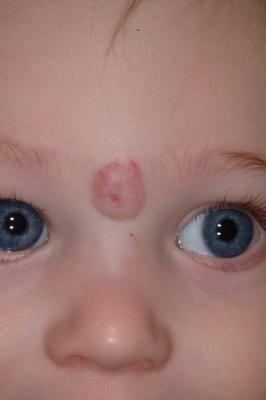Hemangiomas are common skin growths that first appear during infancy as pink or bright red spots or bumps. They continue to grow until the child is about 18 months to 2 years old.
Hemangiomas are caused by an abnormal build-up of blood vessels in the skin or organs. They can appear anywhere on the body and vary in size and depth. Hemangiomas are not technically "birthmarks" because they are not present on the skin at birth. They differ from port wine stains that are present at birth with a fixed size.
There are three main types of hemangiomas: superficial, deep, or mixed.
Most hemangiomas are superficial and appear on the topmost layer of skin when first diagnosed. Superficial hemangiomas may appear bright red with a rough surface, similar to a ripe strawberry. This has lead to their being called a "strawberry hemangioma".
Deep hemangiomas may not display any redness on the surface of the skin. They tend to create large, soft bluish-colored masses.
Hemangiomas that have both superficial and deep components are called "compound" or "mixed". Compound hemangiomas tend to be large and can cause medical complications when they appear on the face.
Children with multiple deep or mixed hemangiomas are at risk of having hemangiomas elsewhere in the body, such as the liver.
Children with large hemangiomas that cover sections of the head and/or neck may have a disorder called PHACES Syndrome that may involves complications with eye, heart and brain.
How are hemangiomas treated?
The approach to treatment depends on the size and location of the hemangioma, as well as the stage of the hemangioma.
There are three stages in the lifecycle of a hemangioma: rapid growth, resting, and involutional (when it begins to disappear). Hemangiomas that are causing problems while still in the growing phase are in greater need for treatment than those that were tolerated and now shrinking.
Small, slow-growing growths may go away on their own and need no treatment at all. This process may take place over several years. The majority of hemangiomas are not associated with any complications. The most common complication is a breakdown of the skin (ulceration) that can result in bleeding and may require wound care.
Larger hemangiomas that grow quickly, are cosmetically deforming, or affect vision, hearing, breathing, or other body functions should be treated early and aggressively. Even after being allowed to shrink on their own, larger hemangiomas can leave behind saggy, stretched skin that may require additional treatment.
Treatment options include:
- Laser are frequently used for reducing the appearance of early-stage, superficial, or small hemangiomas. Lasers work by heating and shrinking the blood vessels within the growth. Scarring is minimal. Lasers are not an effective treatment for deep hemangiomas.
- Propranolol is a beta blocker normally used to control high blood pressure. Propranolol is being used increasingly for complicated hemangiomas in infants.
- Oral or injected steroids can help shrink deeper growths; this treatment may be combined with cryosurgery (liquid nitrogen that freezes off superficial growths) or laser. This is best if the treated area is small and not located on the face. Children and infants often tolerate steroids well and can be safely tapered off the medication
- Alfa-interferon is recommended for persistent hemangiomas that do not respond to steroids, infected lesions, or those that are dangerous (affecting breathing or other vital functions). Because of the alfa-interferon's association with spastic dysplegia (a disorder that causes problems with walking) in children, doctors use it with extreme caution.
- Surgical removal may be recommended for life-threatening or disfiguring hemangiomas that have not responded to any other treatment.
Source: Vivacare
Last updated : 1/8/2019